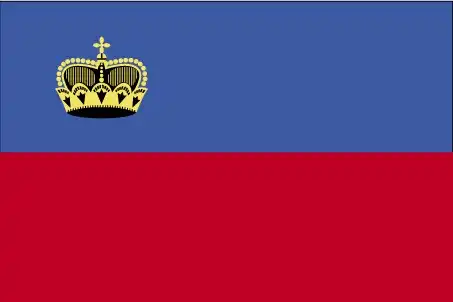Liechtenstein Flag
National Flag of Liechtenstein
Liechtenstein Flag Display

Quick Facts About Liechtenstein and Liechtenstein Flag
- Adopted:
- Aspect Ratio:
- 3:5
- Capital:
- Vaduz
- Population:
- Approximately 39,000 (2023)
Flag Description
Liechtenstein’s national flag is a horizontal bicolor of blue over red, with a gold princely crown in the canton. The combination reflects both dynastic loyalty and national distinctiveness.
Symbolism & Meaning of the Liechtenstein Flag
The blue stripe symbolizes the sky and pride in family heritage; the red represents the warmth of domestic hearth fires and the people’s vitality. The gold crown affirms the sovereignty of the principality and unity between the monarchy and citizenry.
Historical Background of the Liechtenstein Flag
Blue and red were used as princely livery colors from 1764 and enshrined in the constitution in 1921. At the 1936 Olympics, Liechtenstein discovered its flag matched Haiti’s, prompting the addition of a gold crown in 1937. A refined version of the crown was formally adopted by law on 30 June 1982 to standardize appearance.
Design Elements of the Liechtenstein Flag
The flag is split horizontally in proportions 3:5, with blue upper half and red lower half. The gold crown resides in the canton, sized proportionally to preserve visual balance. Official laws define variant formats for vertical banners and car flags, all maintaining the crown’s upward orientation.
Usage & Protocol of the Liechtenstein Flag
Liechtenstein uses its flag on public buildings, national events such as State Day, and international representation. Though small, flag etiquette is formal: it must remain clean, be raised at sunrise and lowered at sunset, and never touch the ground. Military and civil ensign variants correspond with national heraldic traditions.
Frequently Asked Questions
What do the colors of the Liechtenstein Flag represent?
The blue stripe symbolizes the sky and pride in family heritage; the red represents the warmth of domestic hearth fires and the people’s vitality. The gold crown affirms the sovereignty of the principality and unity between the monarchy and citizenry.
When was the Liechtenstein Flag adopted?
The Liechtenstein flag was adopted on 30 June 1982 (crown added to original bicolor in 1937), marking an important milestone in the country's development as an independent nation.
What is the aspect ratio of the Liechtenstein Flag?
The Liechtenstein flag has an aspect ratio of 3:5, which determines the proportional relationship between its width and height for official display purposes.